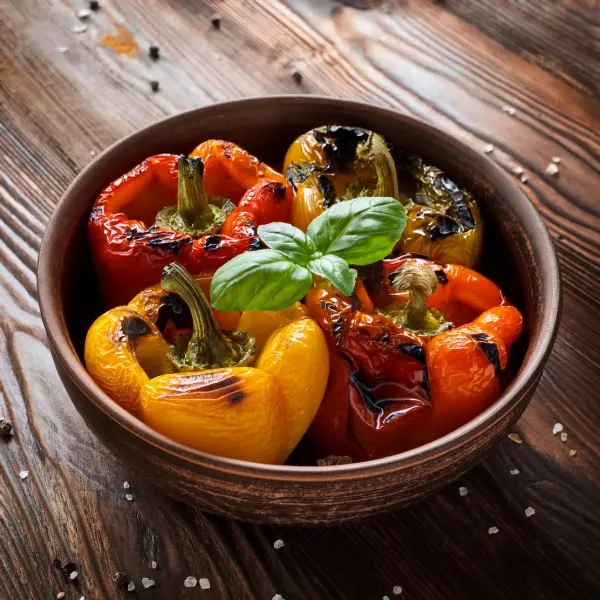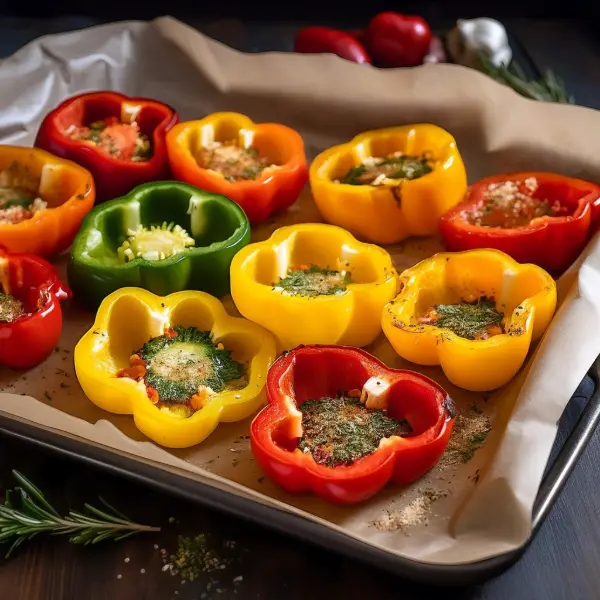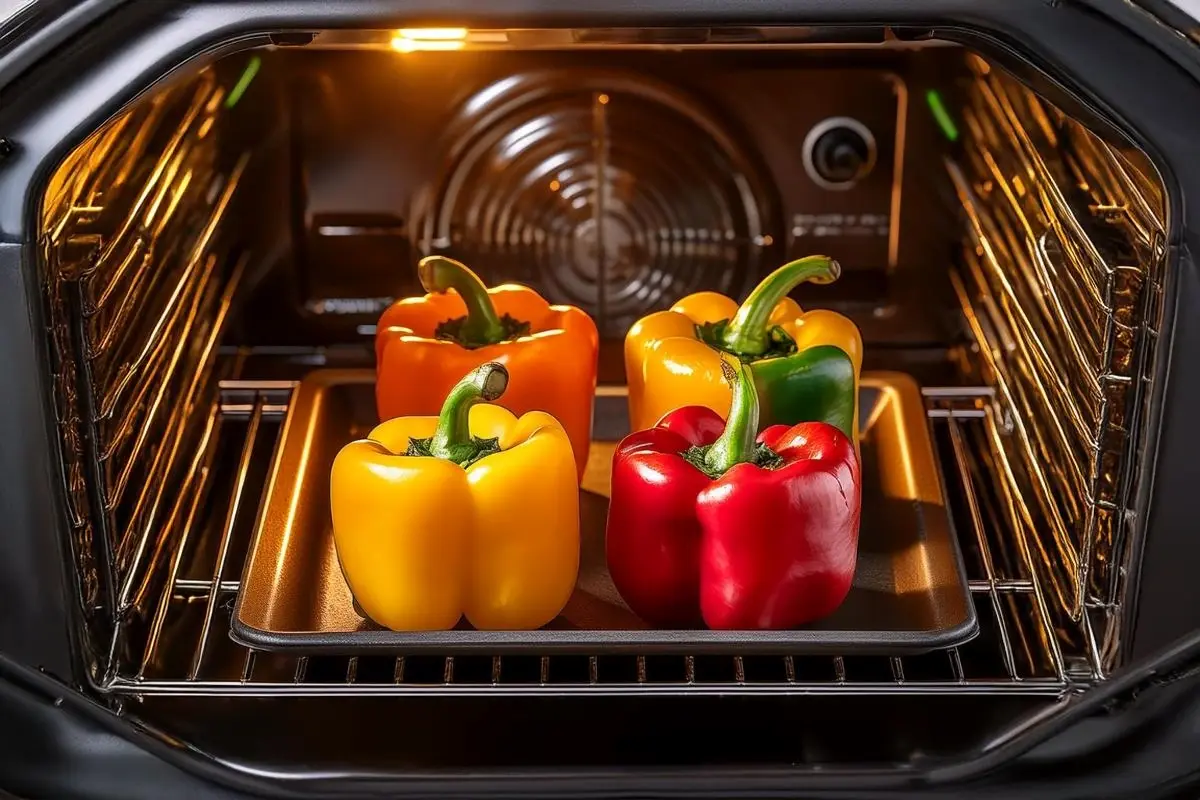Introduction :
When it comes to cooking peppers, one of the most common questions is how long do peppers take in the oven? Whether you’re roasting bell peppers for a salad, charring poblanos for a dip, or baking stuffed peppers for dinner, knowing the right cooking time is essential. This article will cover everything you need to know about oven-roasting peppers, including recommended temperatures, cooking times, and a step-by-step recipe to achieve perfect results. Additionally, we’ll provide tips, nutritional information, and answers to frequently asked questions to ensure your roasted peppers turn out delicious every time.
Factors That Affect How Long Peppers Take in the Oven
The time it takes for peppers to roast in the oven can vary based on several factors. Understanding these variables will help you adjust your cooking time for the best results.
What Affects How Long Peppers Take in the Oven?
When asking how long do peppers take in the oven, it’s important to consider a few key factors. First and foremost, the size and thickness of the peppers play a significant role in cooking time. Larger peppers take longer to roast, while smaller ones cook faster.
Additionally, the way you prepare the peppers can impact the cooking duration. Whole peppers will take more time to roast compared to halved or sliced peppers. Furthermore, the oven temperature you choose can speed up or slow down the roasting process.
Size and Thickness of Peppers
The size of your peppers matters greatly when determining the cooking time. Whole bell peppers, for instance, can take up to 25-30 minutes to roast at 400°F, whereas smaller, halved peppers might only need 15-20 minutes.
Moreover, the thickness of the pepper walls can affect the cooking time. Thick-walled peppers like bell peppers take longer to soften compared to thin-walled varieties like poblano or Anaheim peppers.
Oven Temperature and Cooking Time
Another crucial factor to consider is the oven temperature. Higher temperatures, such as 425°F (220°C), will roast peppers more quickly, typically within 15-20 minutes. On the other hand, if you’re aiming for a slower roast with more caramelization, you might choose a lower temperature, around 375°F (190°C), which would take 25-30 minutes.
For example:
- Whole Bell Peppers: 20-30 minutes at 400°F
- Halved or Sliced Peppers: 15-20 minutes at 375°F
- Poblano Peppers: 15-20 minutes at 425°F
Type of Pepper and Preparation
Different types of peppers also have different roasting times. Bell peppers, jalapeños, and poblanos each require unique cooking times due to their size and thickness. Furthermore, how you prepare the peppers—whether whole, halved, or sliced—can significantly impact the time they spend in the oven.
For instance, halved peppers roast more evenly and quickly compared to whole peppers, which need more time for the heat to penetrate through.
How to Roast Peppers in the Oven: Step-by-Step Guide
Roasting peppers in the oven is one of the easiest ways to bring out their natural sweetness and enhance their flavor. Plus, it’s a versatile cooking method that works well for a variety of peppers, whether you’re making stuffed bell peppers or charred poblano peppers. Follow this step-by-step guide to achieve perfectly roasted peppers every time.
Ingredients for Oven-Roasted Peppers
Before we dive into the instructions, let’s go over the ingredients you’ll need. These simple pantry staples will help you season your peppers to perfection.
- 4 large bell peppers (any color)
- 2 tablespoons olive oil
- 1 teaspoon salt
- ½ teaspoon black pepper
- Optional: 1 teaspoon Italian seasoning or smoked paprika for extra flavor
Step-by-Step Instructions for Roasting Peppers
Step 1 – Preheat Your Oven
To start, preheat your oven to 400°F (200°C). This temperature is ideal for roasting peppers because it allows them to soften and caramelize without burning.
Step 2 – Prepare the Peppers
Next, wash the peppers thoroughly under running water to remove any dirt. Pat them dry with a paper towel.
For whole roasted peppers, leave them intact. However, if you’re looking to speed up the cooking process, consider cutting the peppers in half or slicing them into strips. Removing the seeds and membranes will also help reduce bitterness.
Step 3 – Season the Peppers
Place the peppers on a baking sheet lined with parchment paper. Drizzle them with olive oil and sprinkle with salt, pepper, and any additional seasonings you prefer.
Use your hands to coat the peppers evenly with the oil and seasonings. Make sure the peppers are arranged in a single layer on the baking sheet to ensure even roasting.
Step 4 – Roast the Peppers in the Oven
Place the baking sheet in the preheated oven. If you’re roasting whole peppers, they will take approximately 25-30 minutes. Turn the peppers halfway through the cooking time to ensure they roast evenly on all sides.
For halved or sliced peppers, the cooking time will be shorter—around 15-20 minutes—depending on how tender you want them.
Step 5 – Peel the Peppers (Optional)
Once the peppers are done roasting, remove them from the oven and transfer them to a bowl. Cover the bowl with plastic wrap or place the peppers in a sealed plastic bag. Let them sit for 10-15 minutes. This step will create steam, making it easier to peel off the skins if desired.
After they’ve cooled slightly, peel off the charred skins with your hands or a knife. Peeling is optional, but it can help remove any bitterness from the peppers.
Step 6 – Serve and Enjoy
Your roasted peppers are now ready to be used in various dishes. Serve them as a side dish, use them in sandwiches or salads, or incorporate them into pasta sauces for added flavor.
Tips for Adjusting Cooking Times Based on Pepper Type
While it’s helpful to know the general cooking times for roasting peppers, the type of pepper you’re using can significantly impact how long they take to roast in the oven. Additionally, preparation methods—such as leaving peppers whole or cutting them into smaller pieces—can change the cooking time. In this section, we’ll cover specific tips for adjusting the cooking time based on the type of pepper.
Cooking Times for Different Types of Peppers
Different peppers have unique textures, sizes, and thicknesses, which all affect how long they need to roast. Knowing how long do peppers take in the oven based on their type will help you achieve the best results.
Bell Peppers
Bell peppers are thick-walled and take longer to roast than thinner peppers. If you’re roasting them whole at 400°F (200°C), expect them to take 25-30 minutes. For halved or sliced bell peppers, they typically need 15-20 minutes to become tender and caramelized.
Quick Tip: To speed up the cooking process, slice bell peppers into strips and lay them flat on the baking sheet.
Poblano Peppers
Poblano peppers have thinner walls and roast more quickly than bell peppers. At 425°F (220°C), they will roast in 15-20 minutes. Poblanos are often roasted until their skin blisters, making it easier to peel them for use in recipes like stuffed poblanos or chili rellenos.
Quick Tip: Turn poblano peppers frequently during roasting to ensure even blistering.
Jalapeño Peppers
Jalapeño peppers are small and thin-walled, meaning they roast much faster than larger peppers. At 400°F (200°C), they only need 10-12 minutes. Roasted jalapeños can be used in salsas, dips, or as a topping for tacos and nachos.
Quick Tip: To reduce the heat of jalapeños, remove the seeds and membranes before roasting.
Sweet Mini Peppers
Sweet mini peppers are similar to bell peppers but much smaller in size. They take approximately 10-15 minutes to roast at 400°F (200°C). These peppers are perfect for snacking, adding to salads, or serving as an appetizer.
Quick Tip: Drizzle sweet mini peppers with olive oil and sprinkle with salt before roasting to enhance their natural sweetness.
Whole Peppers vs. Halved or Sliced Peppers
The way you prepare peppers before roasting also affects the cooking time.
- Whole Peppers: Roasting whole peppers takes the longest because the heat must penetrate through the thick walls.
- Halved Peppers: Halving peppers reduces cooking time by exposing the interior to more heat.
- Sliced Peppers: Slicing peppers into strips or rings allows them to cook even faster and caramelize more evenly.
Adjusting Cooking Time for Thinner Peppers
If you’re roasting thinner peppers like Anaheim or banana peppers, you may need to reduce the cooking time to prevent overcooking. These peppers can roast in 8-12 minutes at 400°F (200°C).
Quick Tip: Keep an eye on thinner peppers while roasting, as they can burn quickly.
Health Benefits and Nutritional Content of Roasted Peppers

In addition to their rich flavor and versatility, roasted peppers offer numerous health benefits. They are packed with essential vitamins and minerals, making them a nutritious addition to any meal. Understanding the nutritional content of roasted peppers can help you make healthier choices when incorporating them into your recipes.
Nutritional Content of Roasted Peppers (Per 100g Serving)
Here’s a detailed breakdown of the nutritional content of roasted bell peppers to help you understand their health benefits.
| Nutrient | Amount per 100g | % Daily Value |
|---|---|---|
| Calories | 40 kcal | 2% |
| Protein | 1g | 2% |
| Total Fat | 3g | 5% |
| Carbohydrates | 6g | 2% |
| Fiber | 2g | 8% |
| Vitamin C | 130% | – |
| Vitamin A | 15% | – |
| Potassium | 210 mg | 6% |
Health Benefits of Roasted Peppers
Roasted peppers aren’t just tasty—they’re also incredibly nutritious. Here are some of the top health benefits of adding roasted peppers to your meals.
Rich in Antioxidants
One of the key benefits of roasted peppers is their high antioxidant content. Peppers, especially red and yellow varieties, are loaded with carotenoids like beta-carotene, lutein, and zeaxanthin. These antioxidants help protect your cells from oxidative stress, reducing the risk of chronic diseases.
Additionally, roasted peppers retain most of their antioxidants, even after cooking. This makes them a great way to boost your intake of nutrients while enjoying a flavorful dish.
Excellent Source of Vitamin C
Did you know that red bell peppers contain more vitamin C than oranges? Roasted peppers are an excellent source of this essential vitamin, which supports your immune system, promotes healthy skin, and aids in iron absorption.
For example, a 100g serving of roasted red peppers provides over 130% of your daily vitamin C needs. Even after roasting, peppers retain a significant amount of their vitamin C content.
Supports Eye Health
Roasted peppers are rich in vitamin A and carotenoids, which are known to support eye health. Lutein and zeaxanthin, found in peppers, help protect your eyes from harmful blue light and reduce the risk of age-related macular degeneration.
Eating roasted peppers regularly can contribute to better vision and overall eye health, especially as you age.
Low in Calories, High in Nutrients
Despite being low in calories, roasted peppers are packed with essential nutrients. They contain a good amount of fiber, which aids in digestion and helps you feel fuller for longer. Plus, their natural sweetness makes them a healthy alternative to sugary snacks.
How Roasting Affects Nutritional Content
Although roasting peppers slightly reduces their vitamin C content, most of their nutrients remain intact. In fact, roasting enhances the absorption of certain antioxidants, like beta-carotene, by breaking down the cell walls of the peppers.
Quick Tip: To maximize the nutritional benefits, roast your peppers with a drizzle of olive oil. This healthy fat helps your body absorb fat-soluble vitamins, like vitamin A.
Common Mistakes to Avoid When Roasting Peppers
Although roasting peppers in the oven seems simple, a few common mistakes can affect the outcome. To achieve perfectly roasted peppers that are tender, flavorful, and charred just right, it’s essential to avoid these pitfalls. Let’s explore the most frequent mistakes and how to prevent them for the best results.
Top Mistakes to Avoid When Roasting Peppers in the Oven
Overcrowding the Baking Sheet
One of the most common mistakes is overcrowding the baking sheet. When peppers are packed too closely together, they release moisture, causing them to steam rather than roast. This prevents the peppers from developing that desirable charred, caramelized texture.
Solution:
Always arrange the peppers in a single layer with enough space between them. Use two baking sheets if necessary to ensure even roasting.
Not Turning the Peppers Halfway Through
Roasting peppers on just one side can result in uneven cooking. The tops may char while the bottoms remain undercooked, leading to inconsistent texture and flavor.
Solution:
Turn the peppers halfway through the cooking time to ensure they roast evenly on all sides. This simple step helps achieve the perfect balance of char and tenderness.
Using the Wrong Oven Temperature
The oven temperature you choose plays a crucial role in how long peppers take in the oven. Setting the temperature too low will slow down the cooking process, making the peppers mushy rather than roasted. On the other hand, an overly high temperature can cause the peppers to burn on the outside while remaining raw inside.
Solution:
For whole peppers, stick to 400°F (200°C) for a balanced roast. For sliced or halved peppers, 375°F to 400°F works best.
Skipping the Preheating Step
Another mistake is placing the peppers in a cold oven. Without preheating, the peppers may cook unevenly, and you’ll miss out on that initial burst of heat that helps with caramelization.
Solution:
Always preheat your oven to the desired temperature before placing the peppers inside. This ensures they start roasting immediately, developing that rich, smoky flavor.
How to Get the Perfect Char on Your Peppers
Achieving the perfect char is key to unlocking the best flavor in roasted peppers. However, it requires a bit of technique.
Use High Heat for a Shorter Time
For a rich char without overcooking, use high heat and roast the peppers for a shorter time. This method works particularly well for thinner peppers like poblano or Anaheim peppers.
Let Peppers Steam After Roasting
After removing the peppers from the oven, transfer them to a bowl and cover with plastic wrap. The trapped steam makes it easier to peel off the skin, which enhances both texture and flavor.
Why Peeling Roasted Peppers Matters
While peeling roasted peppers is optional, it can improve the final dish. Removing the charred skin reduces bitterness and leaves you with tender, smoky peppers that are ready to use in any recipe.
Quick Tip: Use a paper towel to gently rub off the skin for easier peeling.
FAQs About How Long Peppers Take in the Oven

After exploring the various factors that impact cooking time, you may still have questions about how long do peppers take in the oven. To help you achieve perfect roasted peppers every time, here are some of the most frequently asked questions, along with detailed answers.
How Long Do Whole Peppers Take to Roast in the Oven?
Whole peppers typically take 25-30 minutes to roast at 400°F (200°C). The time may vary depending on the size and thickness of the peppers. Larger bell peppers may take longer, while smaller varieties like poblano or Anaheim peppers will roast faster.
Tip: Turn the peppers halfway through roasting to ensure even cooking on all sides.
How Long Should I Roast Halved or Sliced Peppers?
Halved or sliced peppers roast faster than whole peppers. At 375°F to 400°F, they take about 15-20 minutes to become tender and caramelized. Sliced peppers are perfect for adding to salads, pasta, or sandwiches, as they cook quickly and evenly.
Quick Tip: If you want more char on sliced peppers, turn on the oven’s broiler for the last few minutes.
Can You Roast Peppers Without Oil?
Yes, you can roast peppers without oil, but the results may differ. Using oil helps with caramelization, adds flavor, and prevents the peppers from sticking to the baking sheet. However, if you prefer to skip oil for dietary reasons, line your baking sheet with parchment paper to avoid sticking.
Tip: To enhance flavor without oil, season the peppers with herbs and spices before roasting.
Should I Peel Roasted Peppers?
Peeling roasted peppers is optional, but it’s often recommended. The skin can become tough and bitter after roasting, especially if it’s heavily charred. Peeling the peppers gives them a smoother texture and enhances their flavor.
To peel roasted peppers easily, place them in a bowl and cover with plastic wrap or a lid to let them steam for about 10-15 minutes. The steam will loosen the skin, making it easier to remove.
Can I Freeze Roasted Peppers?
Yes, roasted peppers freeze well and can be stored for up to 3 months. Freezing is a great way to preserve roasted peppers for future use in sauces, soups, and casseroles.
How to Freeze Roasted Peppers:
- Let the peppers cool completely after roasting.
- Peel the peppers if desired.
- Place them in an airtight container or freezer-safe bag.
- Label the container with the date and freeze.
When you’re ready to use them, thaw the peppers in the refrigerator overnight or add them directly to your dish during cooking.
What’s the Difference Between Roasting and Baking Peppers?
The terms “roasting” and “baking” are often used interchangeably, but there’s a slight difference. Roasting generally involves cooking at a higher temperature to achieve a charred, caramelized exterior, whereas baking uses lower temperatures for more even cooking without as much browning.
For peppers, roasting is the preferred method because it brings out their natural sweetness and enhances their flavor.
conclusion
Roasting peppers is a simple and effective way to bring out their best flavors. By understanding how long peppers take in the oven and adjusting the cooking time based on their type and preparation, you can achieve perfectly roasted peppers every time. Whether you use them in salads, soups, or sandwiches, roasted peppers add a rich, smoky flavor to any dish.

